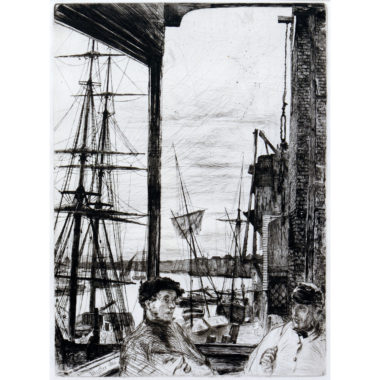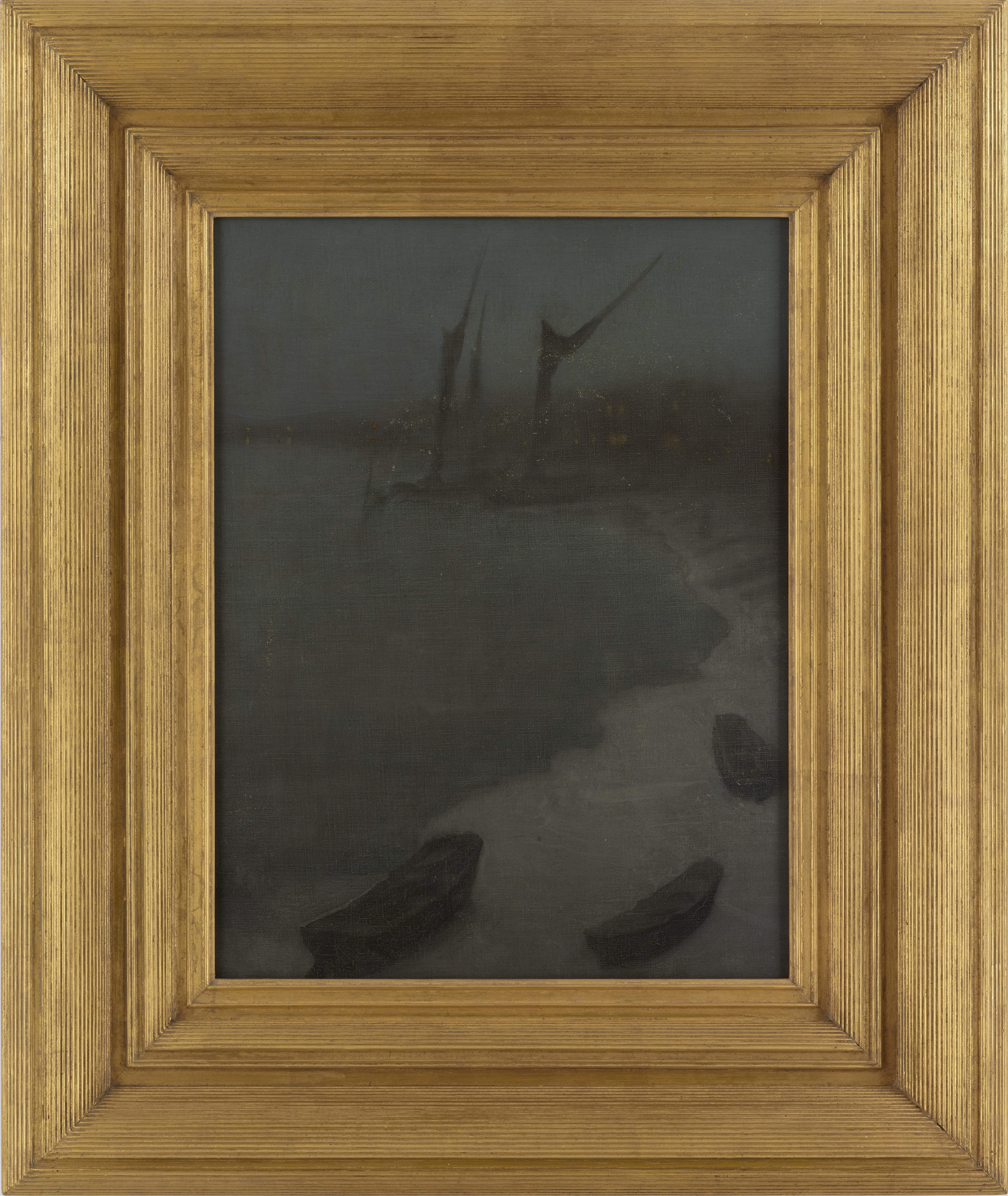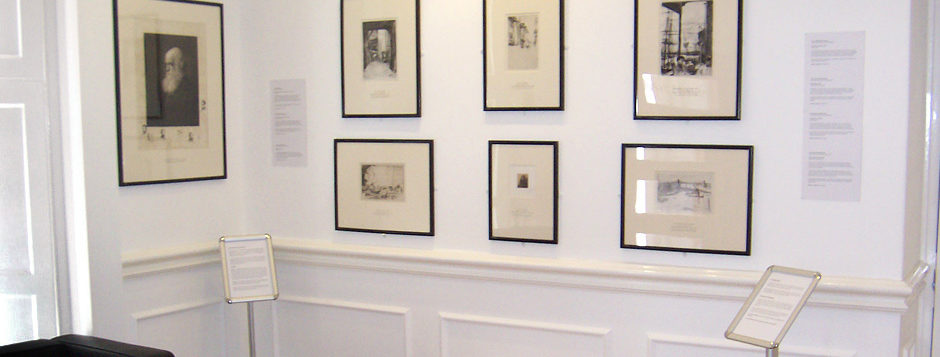
 J.A.M. Whistler, Rotherhithe, 1860. Etching, 27.3 x 20 cm. The McManus: Dundee’s Art Gallery and Museum
J.A.M. Whistler, Rotherhithe, 1860. Etching, 27.3 x 20 cm. The McManus: Dundee’s Art Gallery and MuseumOrchar’s collection boasts examples from Whistler’s etching and drypoint output from the mid 1850s to the late 1870s (1). The earliest, Little Arthur (1857/58) is illustrative of The French Set: Twelve Etchings after Nature. The selection of 12 plates, the majority of which represent an 1858 walking tour of northern France were published in Paris as a series the same year (2). This small (5.7 x 5.1cm) portrait of Haden’s son was likely produced during an extended residence in London between January and April 1858 (3). The latest work, The Beggars (1879/80), represents The First Venice Set: A Series of Twelve Etchings.
A number of works represent Whistler’s residency with Haden in London during 1859, including an extremely rare impression of Seymour standing under a tree (1858/9), Greenwich Park (1859) and The Landscape with Horse (1859). From Whistler’s later period two works are worthy of particular note; the deliberately unfinished Wych Street (1877) depicts the street, demolished around 1901, which stood just north of the prominent theatre district of the Strand. Whistler’s interest in ‘old’ London is perfectly illustrated by The ‘Adam and Eve’, Old Chelsea (1878). The tavern, located on Duke Street just below Battersea Bridge, was destroyed in 1872 during the building of Chelsea Embankment and it seems likely that Whistler’s source of inspiration were photographs of the area taken by James Hedderly (4). By all account, this was an important print for Whistler. As his biographers Elizabeth and Joseph Pennell noted it marked a freedom from the earlier, tighter depictions of London scenes to the more atmospheric Venetian works; ‘Adam and Eve – Old Chelsea has a special interest, for it marks the transition from his early manner in the Thames Set to the later handling in the Venetian’ (5).
The Thames Set
Out of Orchar’s collection of Whistler prints perhaps the most significant is his twelve from The Thames Set. Unlike The French Set, which was only considered as a series once printed, The Thames Set: A Series of Sixteen Etchings of Scenes on the Thames and Other Subjects was conceived as a deliberate project. Whistler started work on the series, shortly after the publication of The French Set, in 1859 and toiled on it throughout the 1860s and early 1870s. Although individual impressions were printed, by Whistler and his French printer Auguste Delâtre, throughout this period it was not published, by Ellis and Green, as a complete set until 1871 (6). Of the sixteen works which constituted the set Orchar owned twelve including The Lime-Burner (1859), a print of which was originally exhibited at the Royal Academy in 1860 as W. Jones, Lime-Burner, Thames Street, and Rotherhithe (1860) (7). Whistler would return to the balcony of the historic Angel Inn, the subject for Rotherhithe, for the painting Wapping (1860-64) (8). The long scratch that tears across the plate was apparently caused by the artist having been startled by a brick falling close to him as he worked (9).
In his concentration of the working docklands area of London Whistler was inspired by the advice offered by the French art critic and poet Charles Baudelaire, especially his review of the Paris Salon of 1845 in which he urged artists to capture scenes of modern urban life: ‘There is no lack of subjects, nor of colours, to make epics. The painter, the true painter for whom we are looking, will be he who can snatch its epic quality from the life of today and can make us see and understand, with brush or with pencil, how great and poetic we are in our cravats and out patent-leather boots’ (10). A number of etchings from The Thames Set were shown at Martinet’s gallery in Paris in 1862 and Baudelaire was suitably impressed. Praising the etching Limehouse he described it as ‘A marvellous tangle of rigging, yardarms and rope; a chaos of fog, furnaces and gushing smoke; the profound and complicated poetry of a vast capital’ (11). The sense of noise and energy of these areas was perfectly captured in a letter from the French painter Henri Fantin-Latour to his parents dated 24 July 1859 in which he narrated a trip to the banks of the Thames with Whistler; ‘We went to a street which was full of (street) sellers and we were there on Saturday evening when everyone does their shopping, everyone shouting, running, grabbing customers by force … foreigners just can’t imagine anything more astonishing. Over the road an enormous iron viaduct crossed obliquely. No, one can’t imagine it, the noise, the shouts, the trains passing beside the little streets which lead down to the Thames, to enter these streets one is forced to stoop … it is appalling!’ (12)
Whistler at the Dundee Fine Art Exhibitions
Although a regular contributor to the various Dundee Fine Art Exhibitions Orchar only started to exhibit his collection of Whistler and Haden’s works in 1879. The exhibition, at the Albert Institute (now known as The McManus: Dundee’s Art Gallery and Museum), opened on the 31 May and closed on the 27 September the same year. Haden dominated the selection, which were displayed in the West Gallery, but there were a number of key Whistlers on show, including Putney Bridge (Old Putney Bridge), Adam and Eve (The ‘Adam and Eve’, Old Chelsea), Little Haden (likely Little Arthur) and Early Morning (Early Morning, Battersea) (13). The 1880 exhibition (19 June to 16 October) also included two from Orchar’s collection; Hungerford Bridge (Old Hungerford Bridge) and Master A.C. Haden (likely Arthur Haden) both shown in the Fourth Gallery (14).
Whistler’s work failed to make another appearance at the Fine Art Exhibitions until the winter of 1882 (6 October to 6 January 1883). The works, all for sale and exhibited in the Fifth Gallery and Hall, included Chelsea, Two Ships, Putney, Fulham, Hurlingham and Tatting (15). Whether Hurlingham was subsequently the same print in Orchar’s ownership it is difficult to ascertain but it is certainly possible he bought it during the exhibition.

In addition to the printed works Orchar also owned the painting Nocturne: Grey and Silver – Chelsea Embankment, Winter (c.1879). Orchar bought the painting on the 9 May 1881 for £32 11s 0d from Christie’s, London. Whistler borrowed it for an exhibition at the Goupil Gallery in 1892 (16).
In Whistler’s correspondence there is scant mention of Orchar. Beyond some reference to the aforementioned Nocturne: Grey and Silver – Chelsea Embankment, Winter there is nothing to indicate any personal familiarity. Whistler, however, does make reference to the 1891 Dundee Fine Art Exhibition in two letters to his wife, Beatrix. Dating from either the 28 or 29 October 1891, Whistler notes: ‘Strange that there is no answer from Mr Orchar about the etchings etc?’ (18). A few days later, on the 2 November, he expressed his concern further: ‘Orchar should be telegraphed to or written to by William [Bell, Whistler’s secretary] to say that the Secretarys [sic] wire has made him anxious about the safety of the etchings…’ (17). Whistler’s concerns are likely a reference to the series of works which were shown in the 1891 exhibition. Held once again at the Albert Institute (21 November to 27 February 1892) it included four Amsterdam etchings Zaandam, Balcony: Amsterdam, The Long House: The Dyer’s, The Pierrot: Amsterdam as well as Cameo No 1 all of which were for sale direct from the artist (19). It is curious to note that none of these works, or any of Whistler’s later Venetian etchings, bar The Beggars, are in Orchar’s collection. Whistler’s work would make a final appearance at the 1895 exhibition (13 November to 2 March 1896) when his 1872 portrait of Thomas Carlyle (‘…where a man of great but somewhat eccentric genius is pourtrayed [sic] with marvellous intellectual insight and artistic competence by another man of high genius more eccentric still’ (20)) was lent by the Corporation of Glasgow for showing in the Second Gallery (21).
|
